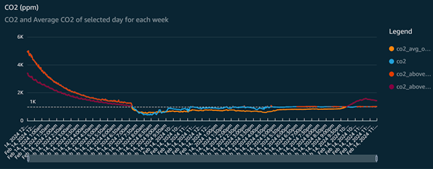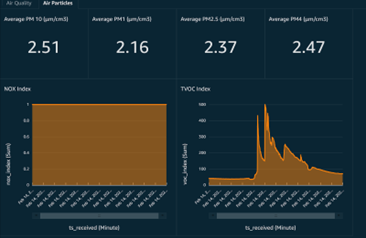Founded in 1990, Russwood is a leading UK provider of high-quality and sustainable timber cladding, flooring, decking and interior cladding products, the company is based in Newtonmore in the Scottish Highlands.
In their Scottish Highlands facility, Russwood processes wood through cutting, shaping, and treating. As Russwood continues to leverage emerging technologies, it enhances its capacity to maintain a safe, healthy, and environmentally responsible workplace, showcasing its leadership in sustainable industrial practices.

Siutation
The Challenge: In their Scottish Highlands facility, Russwood processes wood through cutting, shaping, and treating. These activities release airborne particulates and volatile organic compounds (VOCs), posing challenges to workplace safety and environmental standards. Traditionally, management emphasised safety and environmental responsibility, but lacked real-time air quality data, crucial for safeguarding worker health and minimising ecological impact. Recognising the importance of sustainable practices and exemplary craftsmanship, Russwood recently acknowledged the urgent need for precise air quality and particulate monitoring systems. This initiative aims to ensure health and safety compliance by accurately assessing air quality levels within the work environment. Regular exposure to particulates above recommended levels deteriorates health over time, underscoring the importance of ongoing monitoring.
The responsibility for maintaining air quality standards falls to the Health & Safety officer, who oversees the implementation of monitoring systems to manage and mitigate risks effectively. After careful consideration and consultation with SMDH advisors, the factory decided to implement an air quality and particulate monitoring system. This system features a comprehensive dashboard developed by the SMDH Data team to analyse and display air quality data.
Solution
Overview of Air Quality Dashboard: The dashboard integrates data from two key sensors within the facility—an air quality sensor and an air particle sensor. It offers an initial view that presents general air quality metrics such as CO2 levels, the Air Quality Index (AQI), temperature, and humidity. This view uses colour-coded gauges; for instance, gauge indicators turn red when values exceed safe limits, alerting to potential issues.
A particularly useful feature is the heatmap display of minute-by-minute AQI, which highlights critical times of day, enabling proactive management of air quality. Another section of the dashboard, 'Air Particles', details daily concentrations of various particle sizes (PM1, PM2.5, PM4, PM10) and displays trends in nitrogen oxides (NOx) and Total Volatile Organic Compounds (TVOC).
The Air Quality Index is simplified into a single metric, derived from the levels of particles, nitrous dioxide, ozone, and sulphur dioxide, visualised on a heatmap to show variations throughout the day—from 'good' (light green) to 'poor' (orange). This effective visualisation aids in quickly understanding and responding to air quality issues as they arise.
Successes
The air quality and particulate monitoring system deployed at Russwood Ltd has proven instrumental in enhancing workplace health and safety. It enables precise tracking of air quality, crucial for identifying risk levels and mitigating long-term health risks associated with particulate exposure. The system’s analysis has been particularly valuable in highlighting trends and unexpected increases in particulate levels during operational hours. These insights empower Russwood to proactively manage and rectify air quality issues before they escalate, ensuring compliance with health standards and regulatory requirements. Additionally, the system’s automation aligns with shift patterns, allowing for continuous monitoring and immediate response to deviations from safe air quality levels. This capability not only supports immediate corrective actions but also aids in long-term planning to improve workplace conditions. Ultimately, the implementation of this monitoring system signifies Russwood’s commitment to prioritising the well-being of its employees and reducing its environmental impact. As Russwood continues to leverage emerging technologies, it enhances its capacity to maintain a safe, healthy, and environmentally responsible workplace, showcasing its leadership in sustainable industrial practices.

